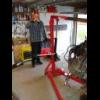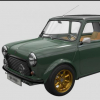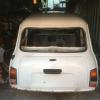Im at swearing stage now.I myself have pretty much only just got to the point where I'm not constantly blowing holes and swearing
A tip for you if you are not aware. I use a piece of copper pipe, sliced lengthwise and then flattened. I then add a couple of slots for intergrips and then use this as a backing piece for any butt welding i do especially on floors. This helps you to prevent blowing holes through.
Thanks for that tip mate. Can I use the flattened copper behind holes Im welding up, such as old bolt holes because at the moment the holes get bigger before they get smaller!
Yes you can, as long as you can get behind then happy days.
Once you get more confident with your welding you can start to do away with the backing copper.
I will say this from experience when you butt weld thing sheet steel ie mini floors you will need a small gap. 1mm which is the thickness of an intergrip is more than enough. the reason behind this is if you your metal is butting up against each other the metal will pucker when you weld. This means when you go to knock back the weld you will thin the welded joint out. Then it will fail.
So a technique as mentioned by Avtovaz is to pulse weld instead of seam welding. So this method is essentially a tack weld but you hold the torch on a short period longer. this will ensure you get decent penetration. When using this process slightly overlap each pulse weld which will give a nice series of Dimes overlapping each other.


















